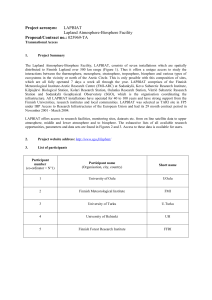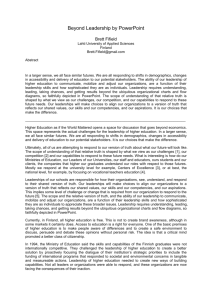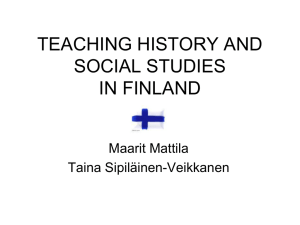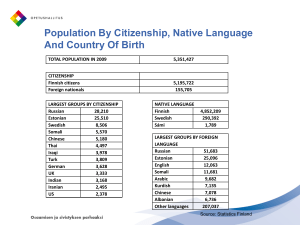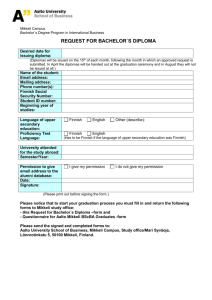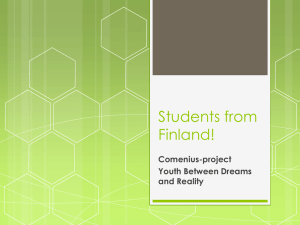Ritva Liisa Pitkänen (Helsinki, Finland)
advertisement
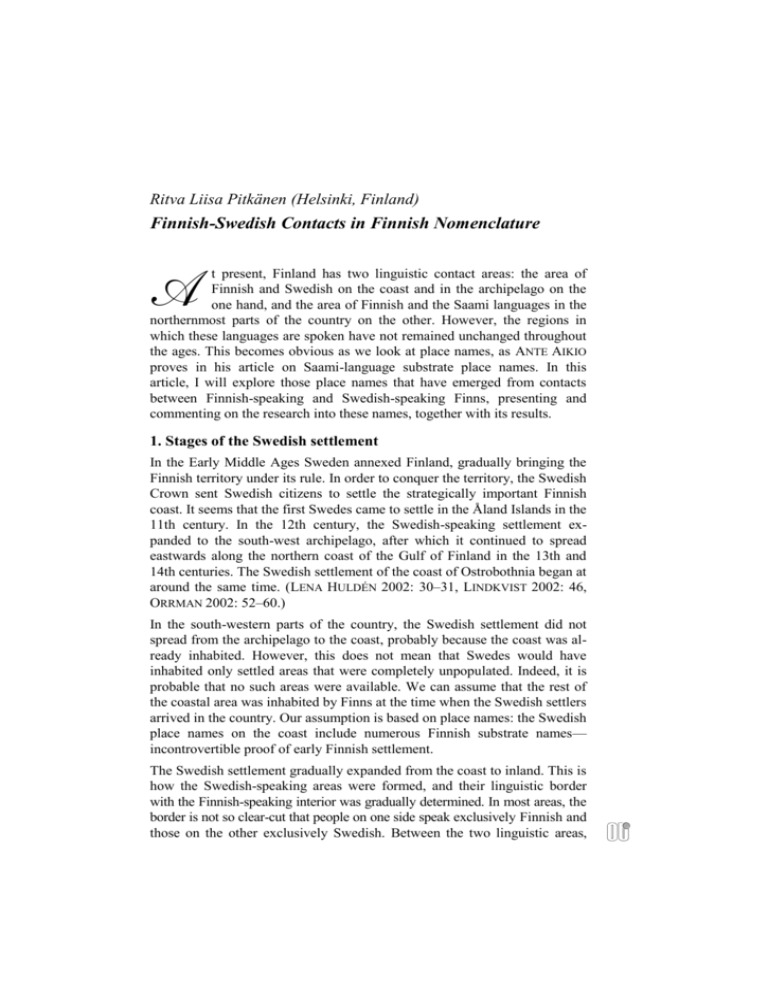
Ritva Liisa Pitkänen (Helsinki, Finland) Finnish-Swedish Contacts in Finnish Nomenclature A t present, Finland has two linguistic contact areas: the area of Finnish and Swedish on the coast and in the archipelago on the one hand, and the area of Finnish and the Saami languages in the northernmost parts of the country on the other. However, the regions in which these languages are spoken have not remained unchanged throughout the ages. This becomes obvious as we look at place names, as ANTE AIKIO proves in his article on Saami-language substrate place names. In this article, I will explore those place names that have emerged from contacts between Finnish-speaking and Swedish-speaking Finns, presenting and commenting on the research into these names, together with its results. 1. Stages of the Swedish settlement In the Early Middle Ages Sweden annexed Finland, gradually bringing the Finnish territory under its rule. In order to conquer the territory, the Swedish Crown sent Swedish citizens to settle the strategically important Finnish coast. It seems that the first Swedes came to settle in the Åland Islands in the 11th century. In the 12th century, the Swedish-speaking settlement expanded to the south-west archipelago, after which it continued to spread eastwards along the northern coast of the Gulf of Finland in the 13th and 14th centuries. The Swedish settlement of the coast of Ostrobothnia began at around the same time. (LENA HULDÉN 2002: 30–31, LINDKVIST 2002: 46, ORRMAN 2002: 52–60.) In the south-western parts of the country, the Swedish settlement did not spread from the archipelago to the coast, probably because the coast was already inhabited. However, this does not mean that Swedes would have inhabited only settled areas that were completely unpopulated. Indeed, it is probable that no such areas were available. We can assume that the rest of the coastal area was inhabited by Finns at the time when the Swedish settlers arrived in the country. Our assumption is based on place names: the Swedish place names on the coast include numerous Finnish substrate names— incontrovertible proof of early Finnish settlement. The Swedish settlement gradually expanded from the coast to inland. This is how the Swedish-speaking areas were formed, and their linguistic border with the Finnish-speaking interior was gradually determined. In most areas, the border is not so clear-cut that people on one side speak exclusively Finnish and those on the other exclusively Swedish. Between the two linguistic areas, 10 Ritva Liisa Pitkänen there are zones of varying width in which both languages are spoken. In certain areas, the Swedish-speaking settlement used to extend further inland than it presently does. Here, again, Swedish settlement can be seen in substrate names of Swedish origin, for example, in the island names in the eastern Gulf of Finland Kukouri, Santio and Lanskeri, which originally included the Swedish generics -ör, -ö ‘island’ and -skär ‘islet’ (ZILLIACUS 1989: 35, 40, 237). The Swedish-speaking area in Finland has traditionally been divided into four provinces: Ostrobothnia (Österbotten in Swedish, Pohjanmaa in Finnish), Åland Islands (Fin. Ahvenanmaa), Turunmaa (Sw. Åboland) and Uusimaa (Sw. Nyland). While Åland remains strongly Swedish-speaking the linguistic situation in the other Swedish areas has not remained stable. The countryside is still mainly Swedish-speaking in all of these areas. In towns, however, the linguistic balance started to change in the 20th century. The most significant changes have taken place in the past few decades, when new native speakers of Finnish moved into the towns in large numbers. The capital region of Helsinki has been affected the most by this development. Gradually, what were formerly profoundly Swedish-speaking parishes in the countryside have become densely populated towns with a majority of Finnish-speaking inhabitants. 2. On research into Finnish-Swedish loan place names Research into loan place names culminated in the 1970s and 1980s. An extensive research project entitled Kieliraja-alueiden paikannimistöt [Nomenclatures in the linguistic border regions] was accomplished through cooperation between Finnish- and Swedish-speaking researchers. It explored the different types of loan names in the bilingual nomenclatures of the linguistic border region between the Finnish- and Swedish-speaking settlements. The etymological and historical background of the old Finnish substrate nomenclature was also studied. The most detailed studies concerned the old loan names of Finnish origin in the Turunmaa archipelago (PITKÄNEN 1985, 1990, 1993, ZILLIACUS 1989, 1994, NAERT 1995). So far, publications on Finnish loan nomenclature in Uusimaa have concerned the composition of the collected data and the distribution of name types (PITKÄNEN 2001, 2002). We do not have a general overview of the loan names in Ostrobothnia, so even their number is unknown. It seems that, with a few exceptions, there are no place names of Finnish origin in Åland (HULDÉN 1982: 95–102). Many of the names of natural features borrowed from Finnish into Swedish have later become names of parishes and villages, that is, the most Finnish-Swedish Contacts in the Finnish Nomenclature prominent and central names of the areas. LARS HULDÉN analyses their etymology in his work Finlandssvenska bebyggelsenamn [Finland-Swedish settlement names] (2001). 3. On the borrowing of place names Place names are culture-specific. They have emerged at a specific time within a specific culture, and they reflect both that time and that culture. In Finland, the cultural background of Finnish and Swedish place names in the linguistic contact areas is roughly the same, since they have been given by residents of the same villages with the same occupations, but with different mother tongues. We can presume that this is the case with the old Finnish substrate names as well. They have emerged in the communities of Finnish settlers that have earned their living through fishing, hunting and animal husbandry. The oldest names given by the Swedish settlers probably also have the same type of cultural background. It is essential from the perspective of borrowing place names from one language to another that names are formed in the same way in Finnish and Swedish and that the name types are similar. The basic place name is a compound with a generic referring to the type of place and a specific referring to a specific feature of that place, for example, in the names of bays Musta/lahti (Fin. musta ‘black’, a specific + lahti ‘bay’, a generic) and Svart/viken (Sw. svart ‘black’, a specific + vik ‘bay’, a generic). As the names are formed in the same way in the source language and the target language, borrowing is a simpler process than, for example, between the Finno-Ugrian languages and Russian, where place names are formed according to different systems (for further details, see the articles by IRMA MULLONEN and JANNE SAARIKIVI in the present volume). There are phonological differences between Finnish and Swedish, which have required phonetic substitution, as the names have been borrowed from one of the languages to another. For example, Swedish has word-initial consonant clusters, which do not exist in the old Finnish vocabulary. These consonant clusters have generally been substituted for single consonants in loan words and names, for instance, in the names Broby (bru:by:) ‘bridge’ + ‘village’ > Ruupyy ja Svartbäck (svartbeck) ‘black’ + ‘brook’ > Vartpekki. The situation in the linguistic border regions is different. The consonant clusters may have been preserved there (RAPOLA 1966: 20–24), for example, in the names Brutasveden (brutasviden) > Brutasvida and Brunalandet (brunala:ndi) ‘brown’ + ‘island’ > Brunalaandi. In Finnish, long vowels may also be found in unstressed syllables, whereas in Swedish the vowels in unstressed syllables are always short. For example, the generics referring to ‘island’ in the Finnish place names -maa ‘large forested island (lit. earth; 11 Ritva Liisa Pitkänen 12 soil)’ and -saari have been substituted in Swedish for -mo and -sor, as in Kivimo (tjivmo) < *Kivi/maa lit. ‘stone’ + ‘island’ and Järvsor (järssor) < *Järvi/saari ’lake’ + ’island’. Their present phonetic forms have also been affected by the changes in Old Swedish: long a has changed into å which has further shortened into o and the final vowel has disappeared (HULDÉN 2001: 456). 4. Types of loan names The research project on nomenclatures in the linguistic border regions referred to above explored the nomenclatures used by the Finnish and Swedish-speaking Finns living in the same regions; their nature, how they have become borrowed from one language to the other, what are the factors that have affected the choice of loan type and the frequency of different loan types (KIVINIEMI & al. 1977, ZILLIACUS 1980). This research was conducted in eight regions situated on both sides of the linguistic border. Both the Finnish and Swedish place names were collected as comprehensively as possible by interviewing people from both language groups in each region. The analysis was based on material thus collected, with over 4,100 FinnishSwedish name pairs. A summary report on the project can be found presenting the various types of loan names and their backgrounds (ZILLIACUS 1980: 317–349). This research material displays considerable regional variation reflecting different periods of settlement history. In order to draw attention to the features of the individual regions, as well, I shall consider the research not only from the point of view of the material as a whole, but also from the perspective of the two largest regional material collections of the research with different backgrounds. One of these was collected from the easternmost bilingual region on the coast of the Gulf of Finland, the municipality of Pyhtää (Sw. Pyttis, PITKÄNEN 1975). This collection includes nearly 400 FinnishSwedish place name pairs. Pyhtää has been a linguistic border region since the 17th and 18th centuries (HULTIN 1926: 80–81), and the use of place names in the two languages is an old, well-established tradition there. The other regional material collection is from the extensive area of Lockvattnet in the Turunmaa archipelago (ZILLIACUS 1994: 97–146). Lockvattnet is bilingual in a different sense to Pyhtää. The majority of the population is Swedish-speaking, with the exception of a few bilinguals who also speak Finnish. Yet, there is an extensive bilingual nomenclature in the area with 300 Finnish-Swedish pairs of place names. These Finnish place names have apparently originated on the Finnish-speaking side of the linguistic border, in connection with the joint fishing undertakings of the two language groups. Finnish-Swedish Contacts in the Finnish Nomenclature The Finnish-Swedish loan names, as is the case with loan names in general, can be divided into two major types: either the name has been borrowed as such or, if necessary, substituted to fit into the phonological structure of the target language or the name has been translated. For example, the Finnish name of an island, Mustasaari (musta ‘black’ + saari ‘island’) may have been borrowed into Swedish either as an adaptation Mussor or as a translation Svartholmen, and the Swedish name of a village Broby (bro ‘bridge’ + by ‘village’) has been borrowed into Finnish, adapted into Ruupyy or translated into Siltakylä. In the adaptations, it is the phonetic form of the name that has been adopted in the target language, whereas in translated loans, it is the meaning. In addition, there are a few occasional modifications to these two major types, the use of which is limited in various ways. A significant factor in both the naming of places and the borrowing of place names is the type of place. It seems that there are language-specific differences in the choice of borrowing type. As we look at the research material in its entirety, the languages do not seem to differ from each other as regards the borrowing of the names. There is roughly the same number of borrowings from Finnish into Swedish as from Swedish into Finnish. We should remember that the borrowings have been affected not only by the linguistic balance of the time of the loan, but also by the earlier history of settlement of the region. For example, in the Lockvattnet region, which is nowadays strongly Swedish-speaking, the loans from Finnish into Swedish (58%) outnumber the loans from Swedish into Finnish (41%) by far, because the majority of the names in the region originate from old Finnish substrate names. In Pyhtää, however, the differences between the languages can be seen in the types of places whose names have been borrowed. The Swedish-speaking population has borrowed more names of natural features than other names from Finnish, whereas the Finnish-speaking population has mainly borrowed the main names of settlements and cultivated land from Swedish. 5. Adapted loans The most common type of borrowing from both Finnish into Swedish and Swedish into Finnish is that of adaptation. These names, borrowed as phonetic substitutes, represent slightly under 60% of the names in the research material covering the entire research area. Yet there are clear differences between the regions. The share of adaptations ranges from 33% to 74% in the various regions. In the entire research material, direct loans seem more frequent from Finnish into Swedish (77%) than from Swedish into Finnish (58%). The loan types have not been chosen individually case by case, but rather, the choices have been based on various general grounds. One of them is the 13 Ritva Liisa Pitkänen 14 structure of the name in the source language. Names with a one nameforming element have nearly always been borrowed as adaptations, for example, the Swedish name of a rock Stålhatten, lit. ‘steel hat’ > Fin. Toolhattu and the Finnish village name Kärvoinen > Sw. Kärvois. In these examples, the choice has probably also been affected by extraordinary forms of the names that would have been difficult or impossible to translate. However, the majority of the ordinary basic names with translatable parts have also been borrowed as adaptations, for example, the Swedish name of a bay Bredviken (breivi:ki) ‘broad’ + ‘bay’ > Fin. Breiviikki. Adaptations seem to be an old loan type. In fact, adaptations are more frequent in the old loan names than in all loan names in general. It would also seem that loan types vary according to language, which can be seen in comparing the map names of different periods in one of the villages of Pyhtää with those in use today. Most of the names on a map from the 1770s were adaptations from Swedish into Finnish of the names of old cultivated lands and central natural features, such as the field name Pastaali < Bastdal (‘bast’ + ‘dale’) and the name of a bay Orholma < Orrholmen (‘black grouse [tetrao tetrix]’ + ‘islet’). However, a couple of decades later, in the maps of the 1830s, the names of the new fields were borrowed as translations, such as Fin. Suurisuo ~ Sw. Stormossen (‘big’ + ‘marsh’). In the case of translated loans, it is often impossible to say which language the names originate from. We can deepen our knowledge of the names by looking at their development in the 20th century. Adaptation loans from Finnish became more and more general in Pyhtää. A typical new loan from Finnish into Swedish is an adaptation where the phonetic differences between the present form and the source are minimal or non-existent, for example, the Finnish field name Rainikko > Sw. Rainikko. The adaptation loans from Finnish into Swedish increased in the late 20th century, as the Swedish-speaking inhabitants, who had become a minority in the area, started to prefer the Finnish forms of the names in order to facilitate communication within the community. For further details, see the section 10. 6. Epexegetic adaptations The advantage of adapted loans in a bilingual community is that the forms used in either language are phonetically close to each other and thus easily recognised as the names of one and the same place. Their disadvantage is, however, that they lack the essential information, the generic that reveals the type of place. In some cases, this disadvantage has been eliminated by supplementing the adapted loan name with a new epexegetic generic, for instance, the Finnish adaptation of the originally Swedish village name (Broby ‘bridge’ + ‘village’ >) Ruupyy has been supplemented with the Finnish-Swedish Contacts in the Finnish Nomenclature generic kylä, referring to ‘village’, which has resulted in the form Ruupyyn/kylä. It is interesting to observe that even though there are a large number of adapted borrowings, the share of epexegetic adaptations is low, accounting for only 4% of the names. How can we explain the small number of epexegetic adapted loans? One possible explanation has to do with the method of material collection. The epexegetic forms are bound to the conversational situation. They are formed and used when it is important to specify the type of place to the conversational partner, for example, someone from outside the community in which the name is used. However, when the names are collected by interviewing, the epexegetic forms are unnecessary, since the type of place is requested separately. 7. Partial adaptations Another infrequent type of adapted loan (ca. 5% of the loan names) is that of names with an adapted first element and a translated final element, for example, the loan name is formed on the basis of the Finnish name of an island Musta/saari (‘black’ + ‘island’), borrowed into Swedish as Muss/holmen (Sw. holmen ‘island [definitive form]) and the Swedish village name Bro/by (‘bridge’ + ‘village’) borrowed into Finnish as Ruu/kylä (Fin. kylä ‘village’). How this type of name emerged is a mystery, and our research material does not provide an unambiguous answer to it. It probably cannot be explained by so-called hybrid names, primarily formed by combining elements from two languages. The hybrid theory is based on the presumption that those people who borrowed the names in question were able to translate the high-frequency geographical terms that form the generics of the names, but that they had to borrow as adaptations such etymologically opaque specifics that they were not able to translate. Nor is there clear evidence that this name type would have emerged as a result of reduction, for example, the Swedish field name Diger/ängen (‘thick’ + ‘meadow [definite]’) > Fin. Tiiker/engin/niitty > Tiiker/niitty (Fin. niitty ‘meadow’). The explanation based on reduction presupposes that the users of a name would have been able to analyse the adapted loan and recognise the element that is equivalent to the generic of the source-language name. 8. Translated loans Translated loans are relatively rare compared to adapted loans in the linguistic border region research material Their share of the entire material is ca. 15 per cent, and their distribution varies greatly according to the region, from less than 6 per cent to over 20 per cent. The difference between the two language groups is that names have been translated from Swedish into Finnish more often (17%) than from Finnish into Swedish (6%). The 15 16 Ritva Liisa Pitkänen reason there are fewer translated loans than adaptations is clear: while any name can be borrowed as a phonetic adaptation, translations are limited by many factors. Firstly, a translation must consist of words that make sense and are thus translatable. Secondly, in the community in which the name is used, there must be people who know both languages and are capable of translating the name. While we can always trace the source language of the adapted loans, some of the translated loans are difficult or impossible to trace back to one of the languages. This is the case with, for instance, an unofficial name of a part of village in Pyhtää, Bastubyn in Swedish and Saunakylä in Finnish (‘sauna’ + ‘village’). Adapted loans are usual in the old loan nomenclature, whereas translated loans are frequent in areas where names were intensively borrowed in the past century. Again, Pyhtää is a good example of such an area. Here, the official Swedish-language village names have been borrowed as adaptations, whereas the unofficial names of parts of a village have been translated, for example, the afore-mentioned Bastubyn ~ Saunakylä. As the share of Finnish-speaking inhabitants has greatly increased, especially microtoponyms (the names of fields, small terrain areas, islands and coastland) with simple basic vocabulary have been translated. As the translated loans seem young, we may wonder why microtoponyms have been recently translated, even though many other equally transparent names were borrowed as adaptations earlier. Perhaps the reason for this is that the taste for names has changed; people may feel that adaptations with a dialectal flavour are too familiar and unofficial, and thus should be avoided in the context of the present official naming practices. What can be said about the age of translated loans? The official Finnish forms of Swedish village names can be established with certainty as late translations. They were formed by the authorities in the early 20th century, for example Broby > Siltakylä and Stensnäs > Kiviniemi (‘stone’ + ‘headland’) in Pyhtää. We could suppose that the answer to the question of when the names were first translated could be found in the Finnish substrate nomenclature that was borrowed into Swedish in the early 11th century. However, we cannot find the answer there. Translated loans that might be found in the substrate nomenclature cannot be traced, since the translated names look like ordinary Swedish names. Nor have we been able to find name types indicating the translated loan origins in the Finnish substrate nomenclature; IRMA MULLONEN’s article in this volume includes examples of such translated loan name types in the Karelian-Veps nomenclature. The question of how old the Finnish-Swedish translated names are thus remains open. Finnish-Swedish Contacts in the Finnish Nomenclature The toponyms which include another place name or a personal name as the specific are a special type of translated loan names. As these names have been borrowed, the generic referring to the type of place has always been translated. The place name of the specific is in the form in which it was originally borrowed into the target language. While the Finnish island name Mustasaari (‘black’ + ’island’) has been borrowed into Swedish as an adaptation, Mussor, the Finnish road name, Mustasaaren/tie (Mustasaari + tie ‘road’) has been rendered in Swedish as Mussor/vägen (väg ‘road’). Similarly, while the Swedish village name Broby has been borrowed into Finnish as a translation, Siltakylä, the road leading to that village is Broby/vägen > Siltakylän/tie. If the specific of the name is a personal name, it was not translated, but the source-language form has been retained, for example, the name of the field Matin/suo with the Finnish forename Matti has been rendered in Swedish as Mattis/mossen (Fin. suo, Sw. mosse ‘marsh’). This also applies to those loan names with a place name as the generic and an appellative specific. The specific has always been translated in these cases, for example, the Swedish name of an island Stora Majsor > Fin. Iso Maisaari (Sw. stor, Fin. iso ‘great’). 9. Reverse loans In regions where the linguistic balance has varied over time, names once borrowed may have been borrowed back into their original source language. In fact, they may have been borrowed several times back and forth between the languages. For example, the Finnish bay name Musta/lahti (‘black’ + ‘bay’) was first borrowed into Swedish as a translation, Svart/viken. As the region again became Finnish-speaking, it once more became necessary to identify the place with a Finnish name. The original Finnish name may thus have been borrowed into Finnish again either as an adaptation: Vartviikki or as a translation: Musta/lahti. There are a large number of cases such as this among the originally Finnish names of parishes and villages in the Swedishspeaking regions. The authorities have re-borrowed them into Finnish as reverse loans, as the regions have gradually become Finnish again and a Finnish form for the name has thus become necessary. For example, the Finnish bay name *Haapalaksi (haapa ‘aspen’ + laksi ‘bay’) was borrowed at an early date into Swedish as an adaptation, Hoplax (hu:plaks), on the basis of which the new Finnish form Huopalahti (literally ‘felt’ + ‘bay’) has been formed. It is difficult to trace reverse loans in he popular nomenclature. We can only suppose that they are found among etymologically obscure names in those regions in which the linguistic balance has varied over time. 17 18 Ritva Liisa Pitkänen 10. Bilingual onomastic environment — place names in use The members of those communities within the linguistic border research area with both Finnish and Swedish-speaking settlements knew the other language of the area at least to some extent, and the people from the different language groups were more or less in contact with each other. An interesting question is how the speakers of the different languages use place names in their mutual communication in such areas. The only region where this has been studied is Pyhtää (PITKÄNEN 1976). As I have noted earlier, bilingualism in the coastal villages in Pyhtää dates from as early as the 17th and 18th centuries. The old estates in the village are Swedish-speaking, but the more recent settlement is Finnish. Initially, both language groups had their own nomenclature, mostly consisting of names borrowed from the other language. The connection between the two nomenclatures is so close that there are only a few instances in which the Swedish and Finnish forms of a place name have different stems, for example, Fin. Pitkäkallio (pitkä ‘long’ + kallio ‘rock’) ~ Sw. Högberget (hög ‘high’ + berg ‘rock’). Whilst analysing the use of names in a bilingual community, we must revert to the borrowing of such names and consider the backgrounds of the various loan types. According to GUNNAR PELLIJEFF, a Swedish researcher (1966: 84–94), the way in which place names are borrowed depends on how well the borrowers know the other language. According to this theory, adapted loans are the oldest because they only require imitation of the phonetic form and do not presuppose knowledge of the source language. As for translated loans, they reflect a more recent loan type, since they require knowledge of the source language. However, we cannot explain the development as simply as that. Even though we might label adapted loans as “mechanical imitations of the phonetic form of the original names”, as PELLIJEFF calls them, a community speaking only one language would not be able to borrow names even as adaptations. If the speakers of one of the languages did not know the other language at all, names would not be borrowed, but each language group would rather form their own nomenclatures. Borrowing always presupposes some knowledge of the source language; for a start, the borrower has to be able to tell which of the words in the source language place names are. As any name can be borrowed as a phonetic adaptation, translation is only possible if the contents of the name are understandable. Thus, old and opaque names must be always borrowed as adaptations, but newer names that are still transparent can also be translated. The names of the most important places familiar to everyone and frequently in use in a bilingual community have turned into different loan variants over time. For example, the Swedish-language village name Broby (’bridge’ + Finnish-Swedish Contacts in the Finnish Nomenclature ‘village’) has been borrowed into Finnish as an adaptation, Ruupyy, as a partial adaptation, Ruukylä (kylä ‘village’) and as a translation, Siltakylä. The different forms date from different periods, but, instead of having been used in chronological order, they have been in simultaneous use. Even though the users of the names have had the option of choosing among several variants, the choice has not been free, but it has been governed by the naming conventions of the community. We all try to speak in such a way that our interlocutor understands what we are trying to say, and in doing so we thus also opt for names that we expect our partner to recognise. Thus, the choice between different name variants is affected by the conversational situation. In order for the interlocutor to understand which place we are referring to, we often need to underline the type of place by supplementing the name with a new epexegetic generic. Among loan names, the problematic cases from the point of view of understanding are typically adapted loans, such as the Swedish-language name of a meadow Breiviikki (< Bredviken ‘broad’ + ‘bay’), which Finnish speakers often refer to using the epexegetic form Breiviikin/niitty (niitty ‘meadow’). There are not very many epexegetic adapted loans in the material collected through interviews in the linguistic border research, but we can assume that they are used more frequently in spontaneous conversational situations. As was expected, the epexegetic forms have been popular among people with limited knowledge of the source language. The linguistic community has a significant effect on the choice of names. If the language groups are of roughly equal size and have approximately the same status, the use of names greatly depends on the conversational situation. If one of the language groups has a dominant position, so does its nomenclature. Even before the research was conducted, Finnish had become the language of the majority in Pyhtää, and there were signs of changing name practices. It was the Swedish-speaking youth of the area that initiated the change. They had given up the Swedish-language names in some cases and adopted the names used by speakers of Finnish. For example instead of using the Swedish-language name of the island Skutholmen (‘sailing boat’ + ‘islet’), they used its Finnish version Kuuttoholma that had earlier been borrowed into Finnish as an adaptation. When asked why they had started using the Finnish forms, they said that it was an attempt to enhance communication. Since it was with speakers of Finnish that they most often spoke about these places, it was sensible to use the Finnish forms of the names. They felt that it would be more practical to use one form of a name within a community simply in order not to burden their memory. LARS HULDÉN (1962: 132–134) noticed the same phenomenon in Ostrobothnia a decade earlier. There, the Swedish-speaking fishermen had started to refer to 19 Ritva Liisa Pitkänen 20 fishing sites with loan names borrowed from Swedish into Finnish. They, too, felt it would be more sensible to use just one name. Nor did they feel that the translated names were different in any way: they were “the same names” in both languages. 11. Substrate names of Finnish origin As we noted previously, Swedish settlers first came to the Finnish coast and archipelago in the 12th century. The region had earlier been wilderness to which the people from the mainland had made fishing and seal-hunting trips from generation to generation. Those regions which had proved favourable as areas for permanent settlement had already been gradually inhabited. In other words, the Swedish settlers came to areas where there was already Finnish settlement. The contacts between the two language groups were close and peaceful, judging by the fact that rather than naming the places in their new area of settlement themselves, the Swedes borrowed the Finnish names. It is impossible to say how many and what types of place names were borrowed in the early stages of Swedish settlement. However, we must assume that the substrate nomenclatures which have been preserved to date represent only a fraction of the nomenclature that was initially borrowed. It seems that names of islands and bays were borrowed in large numbers, because their share of the present loan nomenclature remains considerable. All of the names of Finnish origin were borrowed as adaptations. As we noted above, the question of early loan names remains open, since we have not been able to establish loan names in the substrate nomenclature. It is often difficult to establish which substrate names are loans, since they may not include any elements that would suggest a loan origin. The clearest and most reliable examples of loan names are those that have a final element which can be traced back to the generic of the original name. One of the largest groups that can be traced like this is that of the names of islands. Their final elements -sal(a) and -mo originate from the Finnish words salo and maa in those source names referring to a ‘large island’, for example, in the island and village names Mossala (mossäL) < *Musta/salo (‘black’ + ‘[large and forested] island’) and Jermo (järrmo) < *Järvi/maa (järvi ‘lake’). The final elements -sor and -lot in names referring to smaller islands originate from words in the generic saari and luoto ‘island; islet’, for example, in the island names Pensor (pe:nsor) < *Pärnä/saari (pärnä ‘linden tree’) and Kvelot (kväilot) < *Kuiva/luoto (kuiva ‘dry’). Other recognisable and frequent translated loans are names with the element -lax, whose final element is based on the Finnish word laksi ‘bay’, for example, in the village name Roslax (ru:slakks) < *Ruotsin/laksi (ruotsi ‘Swedish’). Finnish-Swedish Contacts in the Finnish Nomenclature Names with only one name-forming element, and names with a Swedish generic combined with a specific which does not occur in the Swedish nomenclature, are problematic. We have been able to trace the Finnish origins of such names in cases that diverge from Swedish phonology, for example, the name of the estate Rahas (rahas), with the inter-vowel -h-. We can also assume that names with parallels in Finnish nomenclature are of Finnish origin, such as the village name Lem/näs (lemmnes), which may belong to the Finnish *Lempi-names (lit. ‘love; delight’). The names with a unique specific are by no means always loan names. They can equally well be Swedish names with a specific whose origins have become unrecognisable. 12. Place names as historical documents The substrate names of Finnish origin in the Swedish-speaking areas offer us valuable documentary material concerning settlement history. What makes the nomenclature especially valuable is that its age can be established on the basis of settlement history data. The Swedish settlers came to Finland between the 12th and the 14th centuries, and we can assume that the settlers started borrowing Finnish place names soon after their arrival in these areas. The oldest layers of the original Finnish names date from before the Swedish settlement; in other words, the names may date from as early as prehistoric times, whereas the youngest names were given in the Middle Ages at the latest. The substrate names of Finnish origin are relatively numerous everywhere in the Swedish-speaking areas along the Finnish coast. I shall look at the substrate names in the area that has been studied most, that is, the Turunmaa archipelago, where ca. 1,000 place names in the Swedish-language nomenclature have been found to be of Finnish origin. However, compared to the Swedish-language nomenclature, the share of substrate names is minimal. Even in those municipalities which have the most names of Finnish origin, their share of the entire nomenclature is less than 3%. Yet, the Finnishlanguage names are prominent and striking in the onomastic landscape of the archipelago. The reason for this is that they belong to the major names in the area: the names of parishes, villages, and important natural features, such as islands and bays (PITKÄNEN 1985, 1990). What can we conclude concerning the origin and background on the basis of such, verifiably old nomenclature? Firstly, we have to remember that we can only draw conclusions on the basis of those names whose original Finnish forms can be reliably reconstructed. Nevertheless, many of the reconstructed names do not lead into any conclusions, since they tell us hardly anything about their background other than the fact that they have been given by native Finnish speakers. Ordinary names that describe places belong to this 21 22 Ritva Liisa Pitkänen group, for example, the island names Tammis, with the name of the tree tammi ‘oak’, Koi/sar (< koivu ‘birch’), Kvivas (kvi:vas) (< kuiva ‘dry’) and Mos/sala (mossäL) (< musta ‘black’). Some names also offer us information about the name-givers and their culture. In many cases, the original settlers have been traced by comparing place names. The idea of the comparison is that people who have moved elsewhere have often named places in the new regions after places in their old home areas. This also applies to the Turunmaa region, where we can determine the origins of the Finnish-language name-givers on the basis of the toponymy. Our initial hypothesis is that they would have come from the nearest coastal area, the south-western coast of Finland. Indeed, there are names in the archipelago that seem to include place names from the southwestern Finnish mainland, for example, the names of the neighbouring villages Jälist (jeList), Kivis (kivis) and Poutuis (pu:rtus) that have been proven to originate from the names of the neighbouring villages on the mainland, Järäinen, Kiveinen and Puotuinen. Since the source names on the mainland mostly refer to parishes, villages and estates, it has been suggested that places in the archipelago named after them would have been in the possession of these parishes, villages and estates earlier, first as a wilderness and later as places of settlement. However, we can for good reason criticise such comparisons and the conclusions drawn on their basis, especially if there are only a few names that can be connected in this manner. In the Turunmaa archipelago the comparisons are based on stronger evidence, since the name parallels are relatively numerous and the source names can be traced back to specific areas. We can also draw conclusions as to the culture, and above all the livelihood, of the name-givers on the basis of the names. It is evident that fishing was important on the coast and in the archipelago. All of the names of the fishing areas among the Finnish-language names refer to old fishing traditions, for example, those that include hauta- (‘[underwater] depression or pit’), apaja(‘fishing spot’) or luoma- (id.) names referring to fishing areas, such as the village names Houtsala (hoffsäL) from the island name *Hautasalo (salo ‘big island’), Sexnappa (seksnap), from the fishing site *Sääksynapaja, as well as the name of the island and the village Lom (lu:m) from the fishing site *Luoma. The names referring to, for example, animal husbandry, are interesting from the point of view of cultural history, such as the meadow names Lecknit (lekknit), Vånittan (vå:nitton) and the name of a peninsula Nicklot (nikklu:t) with the word niittu ‘meadow’, and names with words referring to cattle, for instance, the island names Härklot (härrklot) (< härkä ‘ox’), Volot (vu:lu:t) (< vuohi ‘goat’) and Karislot (karislu:t) (< karitsa ‘lamb’), islands that used Finnish-Swedish Contacts in the Finnish Nomenclature to be used for grazing cattle. The substrate nomenclature also includes names referring to husbandry, such as the island name Hucklot (hukklu:t), with the word huhta, ‘burned clearing’, the field names Kyttåkern (kytt-) (< kytö ‘moorland burnt-over for cultivation’) and Hampel (hamppäL) < *Hamppupelto (‘hemp’ + ‘field’). There are also names referring to settlements and the partitioning of land, such as the name of the region of Kilamo < *Kylänmaa (kylä ‘village’ + maa ‘island’) and the village name Samslax (sammplas) < *Sampaslaksi (sampas ‘boundary stone’ + laksi ‘bay’). Finnish-language names referring to cattle, husbandry and permanent settlement can be found in those areas with more names of Finnish origin on average than in the research area in general. Some of the names clearly do not belong to the old layer of Finnish names. They have emerged only during the period of Swedish settlement. Another indication of older Finnish settlement is evidenced by the fact that native speakers of Finnish named so many different types of places in the area that the substrate nomenclature seems to consist of names referring to village settlement rather than to names of natural features. These names have largely retained their Finnish phonetic forms, while substrate names usually show a large variety of phonetic and structural changes. Old maps also include names whose form is exactly equivalent to the Finnish source names. This seems to support our conception that there was a large population of native speakers of Finnish in the archipelago and that it remained Finnish-speaking for a longer period than was previously believed. This also explains why places were still named in Finnish later in the Middle Ages. Our conclusions are also supported by certain documents that show that there were still a few native speakers of Finnish in the archipelago in the Early Modern Age. There are documents from the 16th and 17th centuries that mention a few individual people with the epithet Finne. They also mention people with Finnish epithets, such as Thomas Thomasson, also known as Hyfwämies (lit. ‘good man’). The nomenclature of the Turunmaa archipelago shows that we can explore the emergence of settlement and the early cultural features by looking at the substrate names. We can often supplement our knowledge of the nomenclature with archaeological and folkloristic data and thus make even clearer reconstructions of the cultural background. 13. Loan names of Swedish origin I discussed above the nomenclature dating from the former Finnish-speaking settlement that has subsequently disappeared. However, it is not the only Finnish-Swedish substrate nomenclature: there are old Swedish names in 23 Ritva Liisa Pitkänen 24 those Finnish-speaking areas close to the linguistic border, which have so far been left outside of the scope of research. The largest area with old Swedish substrate names extends from the Finnish south-western coast towards Ostrobothnia. Swedish loan names are most frequent in the island parish of Kustavi adjacentto the Swedish-speaking part of the Turunmaa archipelago. There, the nomenclature clearly reflects the settlement history of the area. The oldest names in the area are Finnish. The largest islands, which are the most important natural features of the landscape, have Finnish names, for example, Kauriressalo and Vartsala (cf. salo ‘large island’). Swedish settlement is concentrated in the outer archipelago, where more or less all island names are of Swedish origin, for example, Hurusei < *Furuskär (‘pine’ + ‘island’), Pukkeenluoto < *Bockö (‘goat’ + ‘large island’) + Fin. -luoto ‘island’. Place names on the large islands nearby are old Swedish loan names or more recent names given by Finns. References HULDÉN, LARS (1962) Finsk-svenska blandnamn i Österbotten. In: Namn och Bygd 50, p. 113–134. HULDÉN, LARS (1982) Finska inslag i Ålandsområdets ortnamnskick. In: Studier i nordisk filologi 63, p. 95–102. HULDÉN, LARS (2001) Finlandssvenska bebyggelsenamn. Namn på landskap, kommuner, byar i Finland av svenskt ursprung eller med särskilt svenskt form. Overview by LARS HULDÉN on the basis of the material compiled by NINA MARTOLA, KURT ZILLIACUS, RITVA LIISA PITKÄNEN & al., assisted by ÅKE GRANLUND and CARL-ERIC THORS. The Society of Swedish Literature in Finland. Helsinki. HULDÉN, LENA (2002) När kommo svenskarna till Finland? Trender i en tvärvetenskaplig debatt från slutet av 1800-talet till 1950-talet. In: När kom svenskarna till Finland? Ed. by ANN-MARIE IVARS—LENA HULDÉN. The Society of Swedish Literature in Finland. Helsinki, p. 3–38. HULTIN, HERMAN (1926) Pyttis socken: en skildring. Helsinki. KIVINIEMI, EERO—GUNILLA HARLING-KRANCK—PETER SLOTTE—RITVA LIISA PITKÄNEN (1977) Der Namenbestand an der finnisch-schwedischen Sprachgrenze. In: Onoma 21, p. 426–439. LINDKVIST, THOMAS (2002) Sverige och Finland under tidig medeltid. In: När kom svenskarna till Finland? Ed. By ANN-MARIE IVARS—LENA HULDÉN. The Society of Swedish Literature in Finland. Helsinki, p. 39–50. NAERT, AINO (1995) Ortnamn i språkkontakt. Metoddiskussion med utgångspunkt i ortnamnsskicket i ett finskt-svenskt kontaktområde. Acta Finnish-Swedish Contacts in the Finnish Nomenclature Universitatis Upsaliensis. Nomina Germanica. Arkiv för germansk namnforskning. Uppsala. ORRMAN, ELJAS (2002) Kontinuitet eller diskontinuitet — konkurrerande teorier om den svenska bosättningens ålder i Finland. In: När kom svenskarna till Finland? Ed. by ANN-MARIE IVARS—LENA HULDÉN. The Society of Swedish Literature in Finland. Helsinki, p. 51–61. PELLIJEFF, GUNNAR (1966) Ortnamnslån. Några synpunkter. In: Namn och Bygd. Tidskrift för nordisk ortnamnsforskning. Uppsala, p. 84–94. PITKÄNEN, RITVA LIISA (1975) Pyhtää — Pyttis. In the research project “Kieliraja-alueiden paikannimistöt”. Manuscript. 74 p. PITKÄNEN, RITVA LIISA (1976) Tvåspråkighet och namnbruk. In: Ortnamn och samhälle: aspekter, begrepp, metoder. Ed. by VIBEKE DALBERG— BOTOLV HELLELAND—ALLAN ROSTVIK—KURT ZILLIACUS. NORNArapporter 10. Uppsala, p. 155–163. PITKÄNEN, RITVA LIISA (1985) Turunmaan saariston suomalainen lainanimistö. Publications of the Finnish Literature Society 418. Helsinki. PITKÄNEN, RITVA LIISA (1990) Ortnamn av finskt ursprung. In: “Finska skären”. Studier i åboländsk kulturhistoria utgivna av Konstsamfundet 1990. Konstsamfundets publikationsserie VII. Helsinki, p. 135–193. PITKÄNEN, RITVA LIISA (1990) Uplift as a method of dating the names of natural places. In: Finnish Onomastics — Namenkunde in Finnland. Studia Fennica 34, p. 47–60. PITKÄNEN, RITVA LIISA (1993) Turunmaan saariston suomalais-virolainen asutus. In: Suomen varhaishistoria. Studia historica septentrionalia 21. Oulu, p. 397–403. PITKÄNEN, RITVA LIISA (2001) The oldest toponyms and the origins of the population of the Finnish south coast. In: Congressus Internationalis Fenno-Ugristarum IX. Pars IV. Tartu, p. 53–58. PITKÄNEN, RITVA LIISA (2002) Onko Uudellamaalla virolaisia lainanimiä? In: Nime murre. Pühendusteos Valdek Palli 75. sünnipäevaks 30. juunil 2002. Eesti Keele Instituudi toimetised 11. Ed. by MARJA KALLASMAA. Tallinn, p. 189–198. RAPOLA, MARTTI (1966) Suomen kielen äännehistorian luennot. Publications of the Finnish Literature Society 283. Helsinki. ZILLIACUS, KURT (1980) Ortnamnsförråden vid språkgränsen i Finland. Presentation av ett forskningsprojekt. In: Ortnamn och språkkontakt. Handlingar från NORNA:s sjätte symposium i Uppsala 5–7 maj 1978. NORNA-rapporter 17. Ed. by THORSTEN ANDERSSON—EVA BRYLLA— ALLAN ROSTVIK. Uppsala, p. 317–349. ZILLIACUS, KURT (1989) Skärgårdsnamn. The Society of Swedish Literature in Finland. Helsinki. 25 26 Ritva Liisa Pitkänen ZILLIACUS, KURT (1994) Orter och namn i “Finska skären”. In: “Finska skären”. Studier i åboländsk kulturhistoria utgivna av Konstsamfundet 1990. Föreningen Konstsamfundets publikationsserie XV. Konstsamfundet. Helsinki, p. 283–372.

